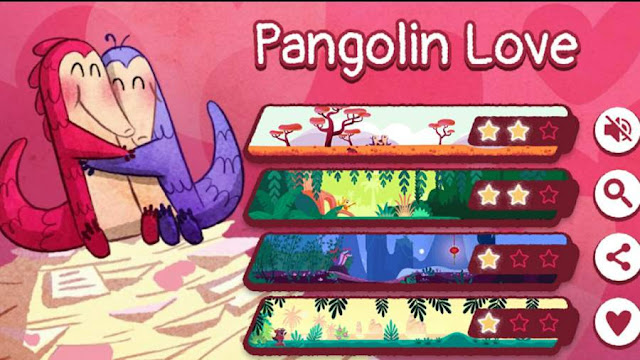Themed around Valentine’s Day, Google’s homepage on Monday is an interactive game where users aid a cute pangolin’s quest for love – so what is it all about?
What is Google’s Valentine’s Day doodle game?
Google has created a games series for Valentine’s Day around endangered animals looking for love, with Monday’s one being dedicated to the pangolin.
The fun four-level game centres on a pangolin rolling to China to meet its mate face-to-face on the big day.
For the Doodle, Google worked with the World Wildlife Fund to help spread awareness about the pangolin, and included a link so players can donate to the cause.
The game took a six-person team of animators and engineers a year to develop, and is one of the company’s most in-depth Doodles ever, according to CNET.
Dig deeper
 |
| photo credit David Brossard |
Pangolins (nocturnal animals) are the world’s only scaly mammal. The eight species of pangolin that roam the wilds of Asia and Africa are strong swimmers who rely on their long tongues and heightened sense of smell to find nourishment.
Sadly however, pangolins are the most trafficked mammal in the world, and all 8 species face a significant threat from poachers, smugglers and heavy deforestation.
Pangolins: Fast Facts
- There are eight species of pangolin
From one extant family, Manidae, there are eight species of pangolin still in existence worldwide, as well as several extinct species over their 80 million year evolution.
Four of the species are Asian: Chinese, Malayan (or Sunda), Indian and Palawan; while the others are African: Tree pangolin, Giant ground pangolin, Cape pangolin and Long-tailed pangolin.
- A pangolin’s tongue can be longer than its body
When fully extended, a pangolin's tongue can be over 40cm long, and starts deep in the chest cavity. Pangolin do not have teeth and are unable to chew, however, so they use their sticky tongues to collect insects - up to 70 million a year - which are ground up by stones and keratinous spines inside their stomachs.
- Pangolins are the only mammals in the world covered in scales
The pangolin's large scales are made of keratin, the same material of which our fingernails, rhino horns and bird talons are made - and account for 20% of its weight. The scales are very hard and protect pangolin against animal predators, yet in traditional Chinese medicine are dried and roasted for medicine an as a result, pangolin scales can sell on the black market for over $3,000 a kilogram, and have even been used to make coats.
- The name means 'something that rolls up'
The ground pangolin got its common name from the Malay (the national language of Malaysia, Brunei and Indonesia) word 'pengguling', meaning 'rolling up', in reference to the animal's defence mechanism of rolling into a tight, near-impenetrable ball when threatened. Unfortunately, this practice makes it even easier for humans to capture and smuggle them, as hunters can simply pick up.
- Some climb trees, others dig holes
With their large, curved claws, pangolins are able both to grip on to overhanging tree branches and dig through concrete. Arboreal pangolins, such as the African long-tailed species, live in trees, while others dig burrows so large a human could stand up in them.
- Even big cats don't know what to do with them
Aside from humans, pangolins' main predators include lions, tigers and leopards. Often, though, rolling up in a ball is enough to outwit the big cats, as a pangolin's keratin scales are too hard for even a lion to bite through.
- Nobody knows how long they live
It is presumed that pangolins have a lifespan of twenty years in the wild, since the oldest recorded pangolin lived for 19 years in captivity. The creatures are very rarely found in zoos, however, as time spent in captivity tends to bring about stress, depression and malnutrition, leading to early death. As such, it is unknown how long a pangolin can live for.
- They emit a noxious acid like skunks
When threatened, pangolins defend themselves by rolling up in a ball and, if needed, lashing out with their tale - the scales on which can easily cut a predator's skin. In addition, with their skunk-like-machinery, they are also able to emit a noxious-smelling acid.
- Millions have been traded and killed in the last decade
It is estimated that 100,000 pangolins are captured every year from across Africa and Asia, with most shipped to China and Vietnam, where their meat and scales are sold. As a result, all eight species of pangolin now feature on the International Union for the Conservation of Nature (IUCN) Red List of animals threatened with extinction.
- Their eyesight is dreadful
Of the eight species of pangolin only one, the long-tailed pangolin native to west and central Africa, is regularly active during the day. The rest are nocturnal and, relative to their body size, have very small eyes. This means they have poor eyesight, instead locating termite mounds and ant hills with a strong sense of smell and hearing.
- Dating can be difficult
Pangolins are sexually dimorphic, meaning the genders differ wildly in weight. Most male pangolins are up to 50 per cent heavier than females, while the Indian species can reach 90 per cent. There is no defined mating season, and pangolins are largely solitary aside from mating, so males attract the opposite gender by marking their territory with urine and waiting for a female to find them.
- Their closest relative might not be an anteater
They may be prehistoric, but scientists have changed their minds over the taxonomy of pangolins. It was previously thought the mammals were a member of the Xenarthra family, which includes the similar-looking anteaters, sloths and armadillos. New evidence, however, has shown a closer relationship to the Carnivora, a diverse order containing hyenas, bears and wolves.
[sources: The Sun & The Telegraph]



